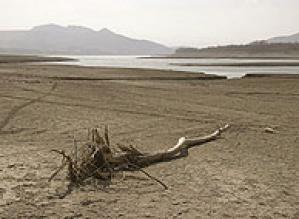

|
News, September 2005Record minimum rainfall brings crisis toSpanish agriculture and threatens supplies to homes30th September. 60,000 jobs in agriculture are threatened in Murcia alone as Andalucia, Murcia and Madrid introduce bans on the use of water for gardens, pools and even agriculture. The hydrological year, ending today, has seen the lowest rainfall since records began and there is no let-up in sight. indeed, even with average rainfall through the coming months, caution will need to be maintained to build up reserves for next summer.The environment minister, Cristina Narbona has called on all to conserve water, after winter rainfall (November to March) was at its lowest since 1947. Levels in the reservoirs, as we hopefully come to the end of the usually dry summer season, can only guarantee supplies to homes in some parts for a few weeks. And she fears that this may be the first in a series of dry years. In some regions, such as dry Murcia, where intensive agriculture combines with coastal holiday and retirement homes (10,000 British live there permanently), water may need to be rationed for all. At 27th September the reserves in the region are down to 10% and still falling. An urgent transfer of water has just been agreed from the Tagus basin to help, but only for domestic use. There is insufficient water there to help farmers in both basins out of immediate problems. The trouble is, turning off the tap to fields will not only allow crops to die, but put many agricultural workers, among them a high proportion on Africans who live in the most precarious of conditions, out of work.Elsewhere things are not much better. Benidorm's reserves are below 10%, with the Costa del Sol (Malaga) at 14.5% and Costa Brava not far behind. An emergency transfer of reserves from the Tagus basin to Segura was agreed in September, but satisfactory to no one. On the other hand, rain storms in the northern and eastern regions, especially Girona in early September, brought about momentary ease, if not the solution to the drought. The 1947 drought and several dry years at the start of the 1950s brought severe famine to much of Spain, in part relieved by the Marshall Plan. How Spain has changed in these 58 years! Few have yet had taps dry, although that may well change in the coming months and reservoirs have allowed Spain's top money earner, agriculture, to continue production. Again, in the coming weeks, agriculture will have the taps turned off: reservoir water will be piped only for domestic use in many areas.Water Highway ditched14th June. The governments of Valencia and Murcia, regions most affected by the drought and beloved of British and European tourists, have declared today that they are willing to pay the full amount needed to build a 'water highway' to bring Pyrenean water from the Ebro basin to the south east coast. A national plan approved by the previous government was shelved last year as uneconomic and unlikely to bring the desired results: when drought hits the south east, the north east is equally hit, even if it still has more water. Sources: El Mundo, TVE, etc.. |


